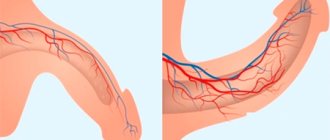What is Xanthomatosis?
A xanthoma is a skin lesion caused by the accumulation of fat in macrophage immune cells in the skin and, less commonly, in the layer of fat under the skin.
Some types of xanthoma indicate lipid disorders (eg, hyperlipidemia or high blood fats), where they may be associated with an increased risk of coronary heart disease and sometimes pancreatitis.
Xanthomas are classified into the following types depending on where they are found on the body and how they develop.
General information
Xanthelasma (xanthoma) of the skin of the eyelids is a benign formation in the form of a flat, slightly raised yellowish plaque on the skin.
The predominant localization of the pathological formation is the inner corner of the upper eyelid. Formations can be either multiple or single, symmetrical, varying in consistency and shape - soft/hard, even flat or nodular. Eyelid xanthelasmas are a type of xanthomas that appear on the eyelids when they are absent elsewhere on the body. Histologically, eyelid skin xanthoma consists of xanthoma cells (histiocytes), which contain intracellular fat deposits, that is, they contain vacuoles that are filled with partially esterified cholesterol . They are located predominantly in the upper reticular layer of the dermis/perivascular region, less often in the area of the appendages. These formations are not prone to malignant degeneration and do not pose a threat to life.
Xanthelasma of the eyelids (a type of xanthoma) is the most common manifestation of xanthomatosis. It occurs more often in females (1.1%) and much less frequently in males (0.3%) aged 15-75 years with a peak at the age of 30-50 years. Xanthomatosis is a disease characterized by multiple deposits of lipid substances, mainly in the skin (elbows, buttocks, thighs), less often in tendons, bones, dura mater), caused by hyperlipidemia .
Eruptive xanthoma
- Lesions usually appear as seedlings of small red-yellow papules
- They most often occur on the buttocks, shoulders, arms and legs, but can occur throughout the body
- Rarely the face and inside of the mouth are affected
- Lesions may be tender and usually itchy
- Lesions may resolve spontaneously within a few weeks
- Associated with hypertriglyceridemia (increased levels of triglycerides in the blood) often in patients with diabetes mellitus (diabetes mellitus)
Symptoms
Xanthelasma is a light orange/yellow plaque that slightly protrudes above the unchanged surface of the skin, with a predominant localization on the upper eyelid (at the border of the fixed/moving part), sometimes at the inner corner of the eye. On palpation, the formation has a soft consistency and is painless. They can be single/multiple, located on one or both eyelids. In some cases, xanthelasmas merge to form a solid yellow stripe with an uneven contour or lumpy elements.
Characterized by slow, steady development, a tendency toward slow fusion of neighboring elements and the absence of spontaneous healing. There are no subjective sensations on the part of the patient. The formation can grow to the size of a large bean, but does not transform into a malignant neoplasm. In cases where xanthelasmas are symptoms of xanthomatosis, they can also be located on the lower eyelid and other parts of the body: on the face, elbow/knee joints, neck, buttocks, etc.
The resulting xanthelasmas do not regress on their own and persist throughout life. In some cases, their number continues to gradually increase. Below is a photo of xanthelasma.
Common xanthoma
- Xanthoma-like lesions are caused by a rare form of histiocytosis.
- Lipid metabolism is normal.
- The skin lesions usually consist of hundreds of small yellowish-brown or reddish-brown bumps that are usually evenly distributed on both sides of the face and torso. They can be especially hard on the armpits and groin.
- Small bumps may join together to form sheets of thickened skin.
- In 30% of affected people, the mucous membranes of the mouth, respiratory tract or eyes (mucous membranes) are affected. Warty plaques in the mouth are called verruciform xanthoma.
- 40% of affected people develop diabetes insipidus, a condition that results in an inability to control water loss (leading to constant thirst and excessive urine production). This occurs due to the overgrowth of histiocytes on the lining of the brain (meninges).
- May affect internal organs (eg liver, lungs, kidneys, etc.)
- Self-limiting and eventually improves on its own, but may persist for many years.
Clinical picture
Xanthomas of the eyelids
The symptoms of xanthomatosis are quite characteristic:
- The rash looks like papules or plaques of soft consistency. The color of the nodules varies from yellowish to orange, in rare cases to red-brown. Dimensions – from 1 mm to 2 cm. Prone to fusion.
- There is no pain syndrome.
- The most common location (face, limbs, buttocks, elbow and knee joints).
- May be accompanied by thinning of the skin and itching.
What causes xanthoma?
There are several main disorders in which xanthoma is caused by a disorder of lipid (fat) metabolism. Because lipids are insoluble in water, they combine with proteins to form compounds called lipoproteins. Lipoproteins transport lipids and cholesterol in the blood to various parts of the body. Based on their size and weight, common lipoproteins are classified as chylomicrons, very low-density lipoproteins, low-density lipoproteins, and high-density lipoproteins (Fredrickson classification). They all play a role in maintaining the metabolic functioning of the body.
Changes in lipoproteins may result from a genetic defect (eg, primary hyperlipoproteinemia) or from an underlying systemic disorder such as diabetes mellitus, hypothyroidism, or nephrotic syndrome. These underlying diseases can cause elevated levels of certain lipids and lipoproteins, which then manifest as cutaneous xanthoma.
Monogenic familial hypercholesterolemia: type IIa
Mutation in the LDL (Low Density Lipoprotein) receptor
- High LDL level
- Total cholesterol in heterozygotes is 9-14 mmol/l
- Total cholesterol in homozygotes is 15-30 mmol/l
Polygenic hereditary hypercholesterolemia type IIIA
Cost of services
| Primary appointment (examination, consultation) with a dermatovenerologist (removal of tumors) | 700 |
| Repeated appointment (examination, consultation) with a dermatovenerologist (after removal of tumors) | 550 |
| Removal of eyelid neoplasm. Removal of xanthelasma of the eyes | 3 500 |
See all prices
Make an appointment with a doctor
In our medical center you can undergo complete treatment of emerging plaques. Our doctors will help identify the cause of the development of formations and eliminate unpleasant cosmetic defects.
Wide range of results
Polygenic familial combined hyperlipidemia: type IIb
- Mixed genetic and life history causes
- Elevated total cholesterol levels
- Elevated triglyceride levels
- Low HDL (High Density Lipoprotein) Cholesterol
- Elevated LDL cholesterol levels
- LDL may be normal levels but denser and more likely to cause atheroma (sebaceous cyst)
Moderate hypertriglyceridemia
- Often also associated with high blood pressure, obesity, diabetes, metabolic syndrome, high insulin levels, high uric acid levels
- This may be due to alcohol or medications such as systemic steroids, isotretinoin, acitretin
- Triglycerides 2_10 mmol/l
- Often associated with low HDL cholesterol levels
Severe hypertriglyceridemia: Types 1 and V
- Mixed genetic and life history causes
- Diabetes
- Familial LPL (lipoprotein lipase) deficiency
- Triglycerides > 10 mmol/l
- Elevated total cholesterol levels
- Raised chylomicrons
- Elevated LDL cholesterol levels
Wide beta hyperlipoproteinemia: type III
- Rare mutation of the apo E gene
- Triglycerides 5-20 mmol/l
- Total cholesterol 7-12 mmol/l
The reason for the appearance of xanthoma with normal levels of fat in the blood is currently unclear.
Traditional medicine methods
Traditional methods of treatment are used as an aid. The essence of the method is to take herbal infusions and decoctions, as well as external influence on the elements of the rash.
Take internally:
- for a choleretic effect: yarrow herb, birch buds, dandelion roots, corn silk, hellebore roots, rose hips;
- to facilitate the work of the liver: chicory stems and leaves, immortelle flowers, milk thistle herb, artichoke leaves, celandine herb;
- to stimulate pancreatic function: valerian roots, St. John's wort, dill seeds, elderberry flowers, elecampane rhizomes, blueberry leaves.
For external treatment use:
- juice of fresh immortelle (aloe);
- baked onion;
- Golden mustache;
- a mixture of vegetable oil and salt;
- badger fat.
Before using traditional medicine methods, you should first consult a doctor.
What examination is required to treat xanthoma?
A skin biopsy may be required to confirm the clinical diagnosis of xanthoma.
Appropriate blood and urine tests and x-rays are performed to determine the cause of abnormal lipoprotein levels, if present. The risk of cardiovascular disease, including heart attacks, peripheral vascular disease and stroke, increases with elevated levels of certain lipoproteins. It is important to identify contributing factors so that appropriate therapy can be instituted.
Tests and diagnostics
The diagnosis is made by examining the patient based on the location/characteristic appearance, color and consistency of the mass. During examination, diascopy is used - pressing on the neoplasm with a glass slide, which allows you to bleed the formation and clearly determine their yellow color and the contours of the formation. If necessary, a lipid profile study is prescribed: determination of lipoprotein/cholesterol and triglyceride fractions in the blood serum. Differential diagnosis must be carried out with dermal cysts, wen, elastic pseudoxanthoma, syringoma and other skin tumors.
How does xanthoma heal?
The primary goal of treating xanthoma that is associated with an underlying lipid disorder is to identify and treat that lipid disorder. In many cases, treatment of the underlying disorder will reduce or resolve the xanthoma. In addition, treating hyperlipidemia will reduce the risk of heart disease, and treating hypertriglyceridemia will prevent pancreatitis. Lipid disorders are treated with changes in diet and lifestyle, with or without medications.
Dietary measures should include:
- Prepare most dishes from vegetables, salads, grains and fish
- Minimize saturated fat (found in meat, butter, other dairy products, coconut oil, palm oil)
- Minimize your intake of simple refined sugars found in carbonated drinks, sweets, cookies and cakes
- If you are obese or overweight, aim to lose weight slowly by reducing your calorie intake and increasing exercise.
Very effective medications may also be prescribed. These may include:
- Statins are pharmaceutical drugs designed to combat high levels of cholesterol in human blood (HMG-CoA reductase inhibitors). Such as simvastatin and atorvastatin reduce the production of cholesterol by the liver, resulting in lower LDL cholesterol, increased HDL cholesterol and a mild reduction in triglyceride levels. Treatment should be monitored by regular blood tests to check lipid levels and ensure that liver and muscle enzymes are normal, as statins sometimes cause problems, especially when given at higher doses.
- Fibrates, such as bezafibrate, may be added to reduce triglyceride production by the liver, lower triglyceride levels, and increase HDL cholesterol levels. They may cause gastrointestinal side effects.
- Ezetimibe may be added in high-risk patients or those who do not tolerate higher doses of statins. It reduces the absorption of cholesterol from the intestines, lowering total and LDL cholesterol.
- Nicotinic acid lowers cholesterol, LDL cholesterol and triglycerides, and increases HDL cholesterol. At therapeutic doses of at least one gram per day, it causes redness of the skin. Its analogue, acipimox, is better tolerated.
- Cholestyramine and colestipol are rarely used because they are not as effective as the drugs listed above and are poorly tolerated.
Surgery or locally destructive techniques may be used to remove xanthomas that do not resolve spontaneously or with treatment of the underlying cause. Advanced xanthoma that affects vital organ functions can be treated with chemotherapy drugs or radiation therapy.
Consequences and complications
Xanthelasmas are not dangerous because they are a benign formation and there is no possibility of their degeneration into a malignant tumor. They also do not affect vision. Removal of formations is carried out for aesthetic reasons. In isolated cases, especially with injury, inflammation (suppuration) may develop. If we consider the consequences after surgical treatment, we can note frequent relapses of the disease. To avoid such consequences, the patient must strictly follow a diet (vegetable-protein diet) and take medications prescribed by the doctor. Also, a scar (hypertrophic or keloid) may form at the site of surgical removal of the formation. Most often this is noted with a predisposition to the development of keloid scars.











